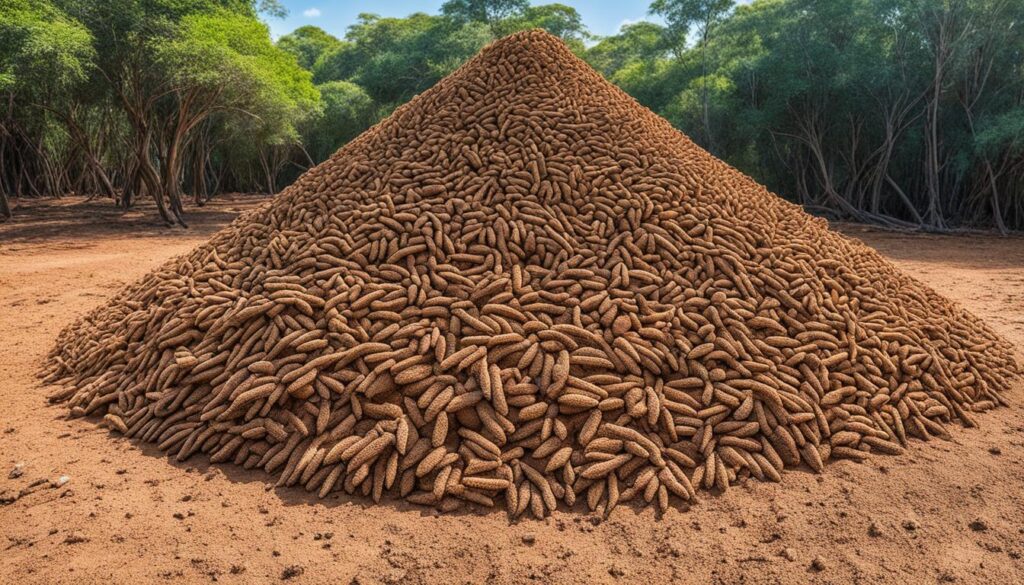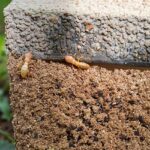The timeline for termite mound formation can vary depending on environmental conditions, but it typically takes around four to five years for a mound to be built. Heavy rainfall can cause mounds to collapse, so termites are constantly working to rebuild their structures and maintain the stability of their colonies.
Key Takeaways:
- A mound can reach heights of up to 17 feet (5 meters) in just a few years.
- It serve as complex structures that provide ventilation, temperature regulation, and protection for the termite colony.
- The construction of a mound is a continuous process, as termites are constantly repairing and rebuilding damaged areas.
- It typically takes around four to five years for a termite mound to be built.
- Heavy rainfall can cause the collapse of these mounds, leading termites to constantly work on rebuilding and maintaining their structures.
The Role of Termites in Mound Building
These fascinating insects create complicated mounds by working together. Each member of large colonies contributes to the collective building. Using touch and vibrations, termites coordinate without a leader. The story goes beyond the builders to explore a fascinating symbiosis with “termitomyces.”
Developed in their nests, the fungus feeds the termites as they foster its development. This sophisticated dance of reciprocity affects termites’ behavior and building tactics as protective architects and fungus-friendly habitat makers. The mound’s many chambers and tunnels regulate temperature and humidity for the fungus.
These animals operate well together. Their capacity to communicate, grow fungus, and work together creates amazing mounds. These constructions demonstrate these organisms’ flexibility and skill as nature’s builders, showcasing their amazing architectural and social complexity.

Termite Mound Structure
| Feature | Description |
|---|---|
| Composition | Termite saliva, feces, and clay |
| Function | Provides ventilation, temperature regulation, and protection for the colony |
| Size | Can reach heights of up to 17 feet (5 meters) |
| Internal Structure | Complex system of chambers and tunnels |
| Ventilation | Promotes air circulation and gas exchange |
| Thermoregulation | Helps maintain a stable nest environment |
The Structure and Ventilation of Termite Mounds
Termite mounds are remarkable structures that go beyond being mere piles of dirt. They serve a vital role as the respiratory system for the termite colony, ensuring optimal conditions for their survival. These mounds are predominantly composed of termite saliva, feces, and clay, forming a sturdy and intricate structure.
The termite mound’s design is optimized for ventilation and air circulation, enabling effective thermoregulation and the exchange of respiratory gases. Within the mound, a network of tunnels and conduits acts as channels for air flow, allowing fresh air to circulate and replenish the colony. This system enables the termites to maintain a stable nest environment, balancing temperature and humidity for the colony’s well-being.
Termites are constantly remodeling the mound in response to changing environmental conditions. By regulating the gas composition and airflow, they ensure that the nest remains habitable and conducive to the survival of the colony. The sophisticated ventilation and thermoregulation mechanisms observed in termite mounds have attracted the attention of architects and engineers, who are exploring the potential of designing energy-efficient buildings inspired by the principles of termite mound construction.
FAQ
How long does it take for a termite mound to form?
The timeline for termite mound formation can vary depending on environmental conditions, but it typically takes around four to five years for a mound to be built.
What is the role of termites in mound building?
Termites live in large colonies and work collectively to build and maintain their mounds. They communicate through touch and vibrations, allowing for coordinated construction. Termites also have a symbiotic relationship with a fungus, which they “farm” inside the nest, providing benefits to both the termites and the fungus.
How are termite mounds structured and ventilated?
Termite mounds are complex structures primarily composed of termite saliva, feces, and clay. They have a system of tunnels and conduits that promote ventilation and air circulation, allowing for thermoregulation and the exchange of respiratory gases. The termites constantly remodel the mound to regulate the nest environment.
- How do termite mounds help regulate temperature? - 7 January 2024
- 10 Effective Termite Control Methods That Actually Work - 4 January 2024
- How Long Does It Take for a Termite Mound to Form? - 21 December 2023




